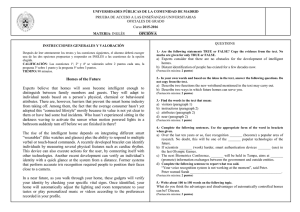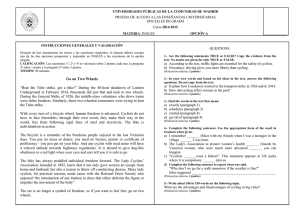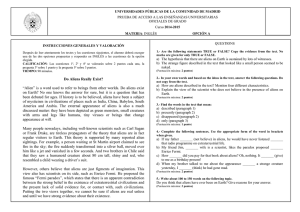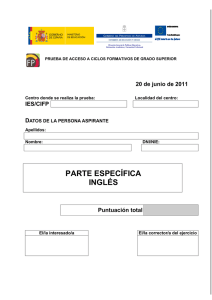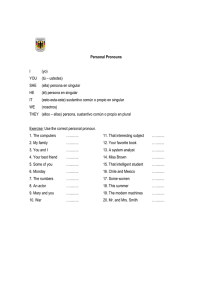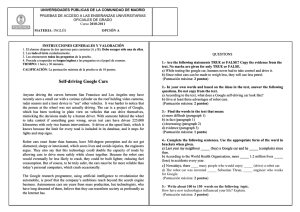inglés - Universidad Complutense de Madrid
Anuncio
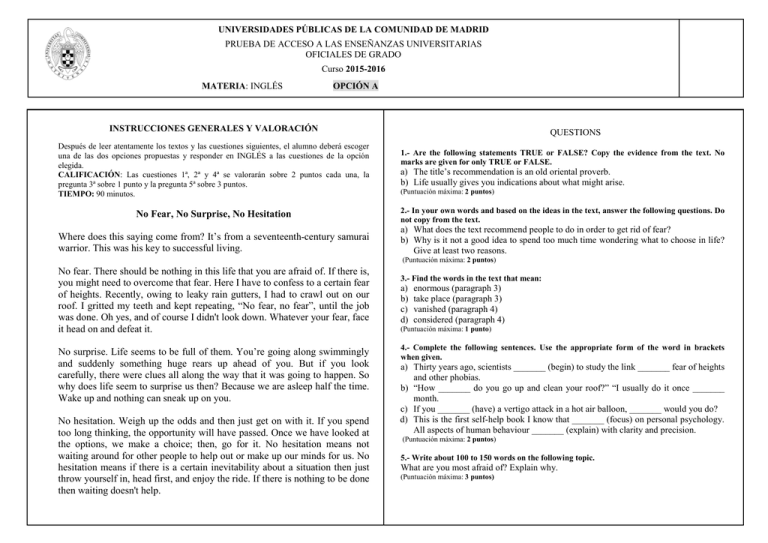
UNIVERSIDADES PÚBLICAS DE LA COMUNIDAD DE MADRID PRUEBA DE ACCESO A LAS ENSEÑANZAS UNIVERSITARIAS OFICIALES DE GRADO Curso 2015-2016 MATERIA: INGLÉS OPCIÓN A INSTRUCCIONES GENERALES Y VALORACIÓN Después de leer atentamente los textos y las cuestiones siguientes, el alumno deberá escoger una de las dos opciones propuestas y responder en INGLÉS a las cuestiones de la opción elegida. CALIFICACIÓN: Las cuestiones 1ª, 2ª y 4ª se valorarán sobre 2 puntos cada una, la pregunta 3ª sobre 1 punto y la pregunta 5ª sobre 3 puntos. TIEMPO: 90 minutos. QUESTIONS 1.- Are the following statements TRUE or FALSE? Copy the evidence from the text. No marks are given for only TRUE or FALSE. a) The title’s recommendation is an old oriental proverb. b) Life usually gives you indications about what might arise. (Puntuación máxima: 2 puntos) No Fear, No Surprise, No Hesitation 2.- In your own words and based on the ideas in the text, answer the following questions. Do not copy from the text. Where does this saying come from? It’s from a seventeenth-century samurai warrior. This was his key to successful living. a) What does the text recommend people to do in order to get rid of fear? b) Why is it not a good idea to spend too much time wondering what to choose in life? Give at least two reasons. (Puntuación máxima: 2 puntos) No fear. There should be nothing in this life that you are afraid of. If there is, you might need to overcome that fear. Here I have to confess to a certain fear of heights. Recently, owing to leaky rain gutters, I had to crawl out on our roof. I gritted my teeth and kept repeating, “No fear, no fear”, until the job was done. Oh yes, and of course I didn't look down. Whatever your fear, face it head on and defeat it. No surprise. Life seems to be full of them. You’re going along swimmingly and suddenly something huge rears up ahead of you. But if you look carefully, there were clues all along the way that it was going to happen. So why does life seem to surprise us then? Because we are asleep half the time. Wake up and nothing can sneak up on you. No hesitation. Weigh up the odds and then just get on with it. If you spend too long thinking, the opportunity will have passed. Once we have looked at the options, we make a choice; then, go for it. No hesitation means not waiting around for other people to help out or make up our minds for us. No hesitation means if there is a certain inevitability about a situation then just throw yourself in, head first, and enjoy the ride. If there is nothing to be done then waiting doesn't help. 3.- Find the words in the text that mean: a) b) c) d) enormous (paragraph 3) take place (paragraph 3) vanished (paragraph 4) considered (paragraph 4) (Puntuación máxima: 1 punto) 4.- Complete the following sentences. Use the appropriate form of the word in brackets when given. a) Thirty years ago, scientists _______ (begin) to study the link _______ fear of heights and other phobias. b) “How _______ do you go up and clean your roof?” “I usually do it once _______ month. c) If you _______ (have) a vertigo attack in a hot air balloon, _______ would you do? d) This is the first self-help book I know that _______ (focus) on personal psychology. All aspects of human behaviour _______ (explain) with clarity and precision. (Puntuación máxima: 2 puntos) 5.- Write about 100 to 150 words on the following topic. What are you most afraid of? Explain why. (Puntuación máxima: 3 puntos) UNIVERSIDADES PÚBLICAS DE LA COMUNIDAD DE MADRID PRUEBAS DE ACCESO A LAS ENSEÑANZAS UNIVERSITARIAS OFICIALES DE GRADO Curso 2015-2016 MATERIA: INGLÉS OPCIÓN B INSTRUCCIONES GENERALES Y VALORACIÓN QUESTIONS Después de leer atentamente los textos y las cuestiones siguientes, el alumno deberá escoger una de las dos opciones propuestas y responder en INGLÉS a las cuestiones de la opción elegida. CALIFICACIÓN: Las cuestiones 1ª, 2ª y 4ª se valorarán sobre 2 puntos cada una, la pregunta 3ª sobre 1 punto y la pregunta 5ª sobre 3 puntos. TIEMPO: 90 minutos. 1.- Are the following statements TRUE or FALSE? Copy the evidence from the text. No marks are given for only TRUE or FALSE. a) It hasn’t been proved that Spaniards’ working schedule affects their standard of living. b) In the text there is no suggestion that it is necessary to improve working conditions in Spain. (Puntuación máxima: 2 puntos) Working Hours It has long been a cliché that Spain is a great place to live but a terrible country to work, and over the last five years many of those lucky enough to have a job are finding themselves working harder, often for fewer wages and with fewer resources. Spaniards sleep fewer hours and work longer days than their European neighbours, but are less productive. One of the most popular advertisements on the social networks this year shows children being called on to write a letter to their parents asking for something. Surprisingly, they don’t ask for toys or sweets. Instead, they ask to spend more time with their parents: time to play, to read stories … in short, time for loving. Surveys show the important role that our working timetables have on inequality and the quality of life in our country. Spanish working women are the most stressed out in Europe. They sleep less and have to juggle family and professional commitments, given that they are still overwhelmingly responsible for housework. Figures also show that, as a result of our timetable, not only children’s performance at school suffers, but their overall development is damaged by lack of sleep as well. We don’t want to be a country built on prejudice and irrationality. We must have the courage to take steps to introduce a more balanced and sustainable approach to working similar to that of other European countries. Future generations will appreciate this and children will hopefully no longer have to write asking their parents to spend more time with them. 2.- In your own words and based on the ideas in the text, answer the following questions. Do not copy from the text. a) What do children demand from their parents? b) How are working hours affecting women’s way of life? (Puntuación máxima: 2 puntos) 3.- Find the words in the text that mean: a) b) c) d) requested (paragraph 2) balance (paragraph 3) complete (paragraph 3) do something (paragraph 4) (Puntuación máxima: 1 punto) 4.- Complete the following sentences. Use the appropriate form of the word in brackets when given. a) Instead of _______ (try) to do our best at work, ours is a culture of being seen on the job rather _______ being effective. b) _______ the crisis, this is still a great place to live_______ the climate, the food and the way people interact with each other. c) Productivity would increase if office hours _______ (be) more rational. Bringing the prime time _______ TV to 9 p.m. would help. d) Complete the following sentence to report what was said. “Why have you applied for a new job if your salary seems to be reasonable?” he asked me. He wanted to know ________________________________________________. (Puntuación máxima: 2 puntos) 5.- Write about 100 to 150 words on the following topic. Working in Spain or abroad. What would you prefer and why? (Puntuación máxima: 3 puntos) INGLÉS CRITERIOS ESPECÍFICOS DE CORRECCIÓN El ejercicio incluirá cinco preguntas, pudiendo obtenerse por la suma de todas ellas una puntuación máxima de 10 puntos. Junto a cada pregunta se especifica la puntuación máxima otorgada. La valoración y los objetivos de cada una de estas preguntas son los siguientes: Pregunta 1: Hasta 2 puntos. Se trata de medir exclusivamente la comprensión lectora. El estudiante deberá decidir si dos frases que se le presentan son verdaderas o falsas, copiando a continuación únicamente el fragmento del texto que justifica su elección. Se otorgará 1 punto por cada apartado. Se calificará con 0 puntos la opción elegida que no vaya justificada. Pregunta 2: Hasta 2 puntos. Se pretende comprobar dos destrezas: la comprensión lectora y la expresión escrita, mediante la formulación de dos preguntas abiertas que el estudiante deberá contestar basándose en la información del texto, pero utilizando sus propias palabras en la respuesta. Cada una de las preguntas valdrá 1 punto, asignándose 0,5 puntos a la comprensión de la pregunta y del texto, y 0,5 a la corrección gramatical y ortográfica de la respuesta. Pregunta 3: Hasta 1 punto. Esta pregunta trata de medir el dominio del vocabulario en el aspecto de la comprensión. El estudiante demostrará esta capacidad localizando en el párrafo que se le indica un sinónimo, adecuado al contexto, de cuatro palabras o definiciones. Se adjudicará 0,25 por cada apartado. Pregunta 4: Hasta 2 puntos. Con esta pregunta se pretende comprobar los conocimientos gramaticales del estudiante, en sus aspectos morfológicos y/o sintácticos. Se presentarán oraciones con huecos que el estudiante deberá completar o rellenar. También podrán presentarse oraciones para ser transformadas u otro tipo de ítem. Se adjudicará 0,25 a cada “hueco en blanco” y en el caso de las transformaciones o ítems de otro tipo se concederá 0,5 con carácter unitario. Pregunta 5: Hasta 3 puntos. Se trata de una redacción, de 100 a 150 palabras, en la que el estudiante podrá demostrar su capacidad para expresarse libremente en inglés. Se propondrá una única opción y se otorgarán 1,5 puntos por el buen dominio de la lengua – léxico, estructura sintáctica, etc. – y 1,5 por la madurez en la expresión de las ideas – organización, coherencia y creatividad.
